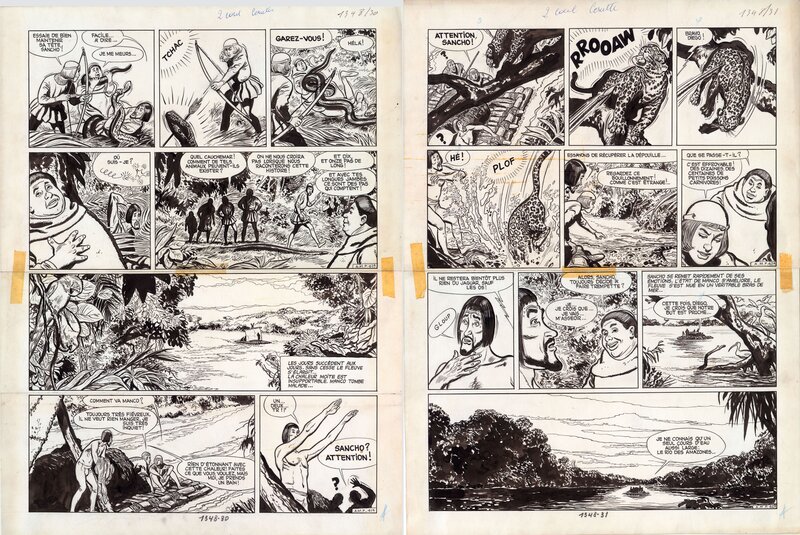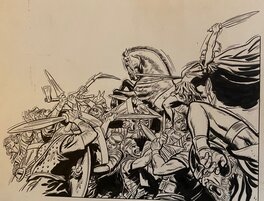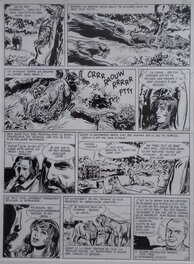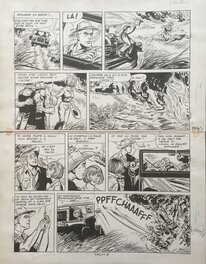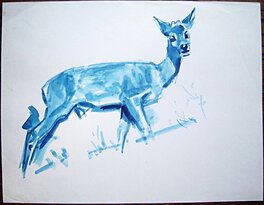In Spad 's collection
Les assiégés de Matchu-Pitchu p41-42
Ink
Encre de chine sur papier à dessin
42 x 55 cm (16.54 x 21.65 in.)
42x55cm pour une planche
Added on 9/17/15
Link copied to clipboard!
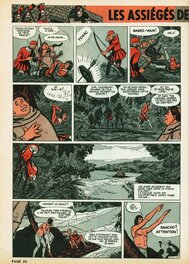
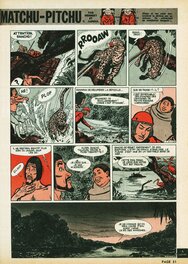
Comment
Deux planches du récit "Les assiégés de Matchu-Pitchu", parues dans le journal de Spirou 1348 du 13 février 1964.Dessin de Herbert sur un scénario de Charles Jadoul.
Ce récit est la suite du "Pays des Quatre Vents".
ll est amusant de noter que Herbert dépeint la jungle amazonienne comme Hergé l'avait fait dans le temple du soleil et Franquin dans le nid des marsupilamis.
On croise un boa, un jaguar, des perroquets et des piranhas pour finir.
Dans les pages précédentes, le frère Iago essaye même de s'asseoir sur un tronc d'arbre qui se révèle être un crocodile.
Ce récit est la suite du "Pays des Quatre Vents".
ll est amusant de noter que Herbert dépeint la jungle amazonienne comme Hergé l'avait fait dans le temple du soleil et Franquin dans le nid des marsupilamis.
On croise un boa, un jaguar, des perroquets et des piranhas pour finir.
Dans les pages précédentes, le frère Iago essaye même de s'asseoir sur un tronc d'arbre qui se révèle être un crocodile.
Thematics
1 comment
To leave a comment on that piece, please log in
About Herbert
Herbert Geldhof was an industrial artist, who worked in Africa for several years in the 1950s. He came back to Belgium in 1956 and began an association with the art agency of Georges Troisfontaines. He was present in the comics magazine Spirou between 1959 and 1971. He started out drawing several 'Belles Histoires de l'Oncle Paul' from scenarios by Octave Joly.
In 1960 and 1961 he was present in Bonux-Boy, the advertising mini-comic for Bonux washing powder, created by Benoît Gillain. In the early 1960s he created two series. The first was 'Simba Lee' with Charlier and the second 'Diégo' with Charles Jadoul. Both series lasted for only two episodes, but in 1964, his third (and final) comics project started, in which he could use his knowledge of Africa.
Together with his tutor Jijé and scenarist Jadoul, Herbert made the series 'Docteur Gladstone'. For this series about a doctor in Africa, Jijé drew the white characters and Herbert the black characters and the backgrounds. After two episodes, Jijé left the team, and Herbert continued the artwork of the series for another four episodes, until the series ended in 1971. He retired from comics in 1980 and focused on painting and sculpting.
Text (c) Lambiek

